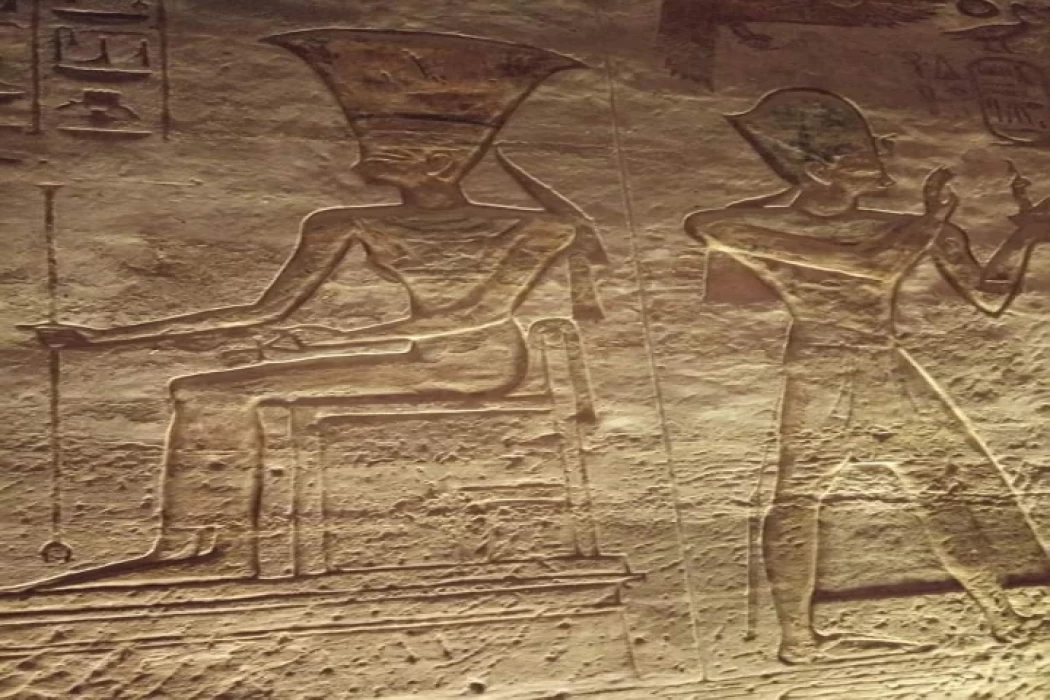
Anuket-Göttin
Anuket (oder Anukis, ihr griechischer Name) ist eine nubische Göttin, die als Dame mit einer Krone aus Federn oder Schilf, mit einem Zepter und dem bekannten Ankh der altägyptischen Kultur dargestellt wird. Ihr Name bedeutet "die, die umarmt", und sie wurde in Sehel und Elephantine verehrt.
In der Nähe des ersten Katarakts des Nils wurde sie ab dem Mittleren Reich zusammen mit ihren Eltern, Khnum und Satis, als heilige Triade verehrt: die Triade von Elephantine. Vorher galt sie jedoch als Tochter des Gottes Amun Ra.
Das Tier, das sie repräsentierte, war die Gazelle, die Zartheit und Zärtlichkeit symbolisierte. Unter diesem Aspekt wurde sie als "Mutter des Königs" dargestellt, die den Pharao als mütterliche und schützende Figur säugt.
Sie war als "Herrscherin von Nubien" bekannt. Sie galt als Göttin der Lust, denn da sie mit dem Nil in Verbindung gebracht wurde, repräsentierte sie die Befruchtung des Landes durch Überschwemmung, wenn der Fluss über die Ufer trat.
Im Laufe der Zeit und durch das Zusammentreffen verschiedener Kulturen wurde sie in Dendera und File mit der Göttin Isis identifiziert und später sogar mit Nephthys in Verbindung gebracht.
Das Hauptzentrum der Anukis-Verehrung, wie wir sie bis heute kennen, war der Tempel auf der Insel Sehel, obwohl sie in ganz Nubien verehrt wurde, in Elephantine, File, Komir, Dendera und Deir el-Medina.
Das ihr gewidmete Fest fand jedes Jahr am 7. Tag des Monats des Gottes Thoth statt. Es war der Zeitpunkt, der mit der Überschwemmung des Nils zusammenfiel. Bei diesen Feierlichkeiten war es üblich, dass die Menschen Gold, Juwelen und wertvolle Gegenstände als Opfergaben hinterließen, die aus Dankbarkeit für die Fruchtbarkeit der Felder ins Wasser geworfen wurden.
Zu diesem Brauch gehörte auch die Gastronomie. An diesen Tagen war es möglich, bestimmte Fischarten zu essen, die während des restlichen Jahres verboten waren.
Wählen Sie Ihr Trio aus den Luxus-Touren in Ägypten und erleben Sie ein bezauberndes Abenteuer in der großen ägyptischen Geschichte.
Anuket (or Anukis, her Greek name) is a Nubian goddess, represented as a lady with a crown of feathers or reeds, with a scepter, and the well-known ankh of Ancient Egyptian culture. Her name means "she who embraces", and she was venerated in Sehel and Elephantine.
The animal that represented her was the gazelle, which symbolized delicacy and tenderness. In this aspect, she was shown as the "mother of the king", suckling the pharaoh as a maternal and protective figure.
She was known as the "ruler of Nubia". She was considered the goddess of lust, because being associated with the Nile, she represented the fertilization of the land by flooding when the river overflowed.
The main center of worship of Anukis, as we know it to this day, was the temple on the island of Sehel, although she was venerated throughout Nubia, in Elephantine, File, Komir, Dendera, and Deir el-Medina.
Every year, the feast dedicated to her took place on the 7th day of the month of God Thoth. It was the moment that coincided with the flooding of the Nile River. In these festivities, it was customary for people to leave as an offering gold, jewels, and precious objects, which were thrown into the water in gratitude for the fertility of the fields.
Part of the custom included gastronomy. On these days, it was possible to eat certain types of fish that were forbidden during the rest of the year.
Religious rituals began with the Ankut festival, when the annual Nile floods began. People threw coins, gold, jewelry, and precious gifts into the river, crediting the water with giving life and the benefits of returning the wealth provided by its fertility to the goddess Ankut. Taboos held in several regions of Egypt against the consumption of certain fish, which were considered sacred, were lifted during this period, indicating that Nile fish species were idolized and used as part of major religious festival rituals.
Anuket's Triad at Elephantine
Like her mother, Satet, Anuket was considered the goddess of hunting animals. According to mythology, Anuket was part of the Elephantine Triad.
The ram-headed fertility deity Khnum, the battle goddess Satet from the Nile flood, and their daughter Anuket, the cataract goddess, made up this triad. Elephantine is situated near Aswan, Upper Egypt, which is on the border between Egypt and Nubia. It was a place of worship for the gods named above. There are other Nile arches in Nubia, which is now Sudan.
When the Nile flooded, the waters entered Egypt via Elephantine. History tells us that Anuket's father, Khnum, guarded and controlled the river's waters... By the 18th century, this place had become a center of worship for the three deities.
















